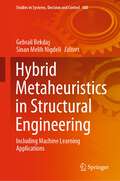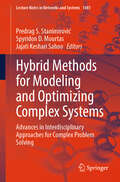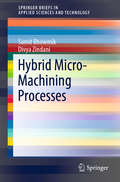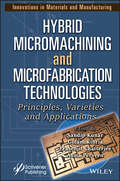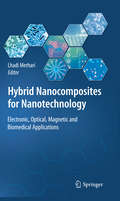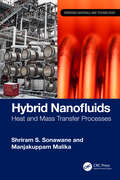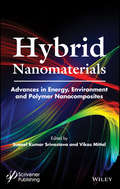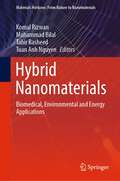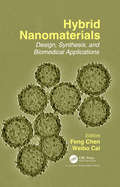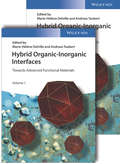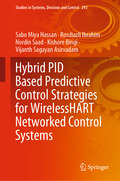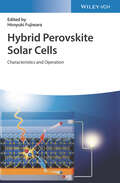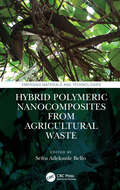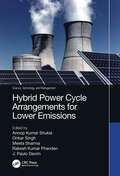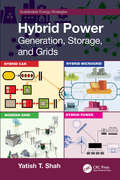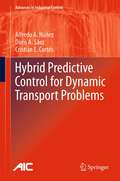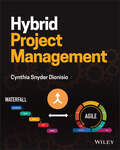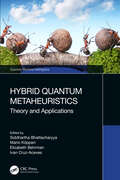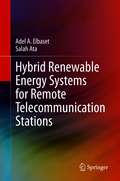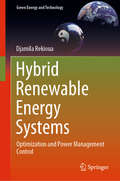- Table View
- List View
Hybrid Metaheuristics in Structural Engineering: Including Machine Learning Applications (Studies in Systems, Decision and Control #480)
by Gebrail Bekdaş Sinan Melih NigdeliFrom the start of life, people used their brains to make something better in design in ordinary works. Due to that, metaheuristics are essential to living things, and several inspirations from life have been used in the generation of new algorithms. These algorithms have unique features, but the usage of different features of different algorithms may give more effective optimum results in means of precision in optimum results, computational effort, and convergence. This book is a timely book to summarize the latest developments in the optimization of structural engineering systems covering all classical approaches and new trends including hybrids metaheuristic algorithms. Also, artificial intelligence and machine learning methods are included to predict optimum results by skipping long optimization processes. The main objective of this book is to introduce the fundamentals and current development of methods and their applications in structural engineering.
Hybrid Metal Additive Manufacturing: Technology and Applications (Advances in Manufacturing, Design and Computational Intelligence Techniques)
by Kishor Kumar Gajrani Parnika Shrivastava Anil DhanolaThe text presents the latest research and development, technical challenges, and future directions in the field of hybrid metal additive manufacturing. It further discusses the modeling of hybrid additive manufacturing processes for metals, hybrid additive manufacturing of composite materials, and low-carbon hybrid additive manufacturing processes. THIS BOOK •Presents cutting-edge advancements and limitations in hybrid additive manufacturing technologies. • Discusses fabrication methods and rapid tooling techniques focusing on metals, composites, and alloys. •Highlights the importance of low-carbon additive manufacturing technologies toward achieving sustainability. •Emphasizes the challenges and solutions for integrating additive manufacturing and Industry 4.0 to enable rapid manufacturing of customized and tailored products. • Covers hybrid additive manufacturing of composite materials and additive manufacturing for fabricating high-hardness components. The text discusses the recent advancements in additive manufacturing of high-hardness components and covers important engineering materials such as metals, alloys, and composites. It further highlights defects and post-processing of hybrid additive manufacturing components, sustainability solutions for hybrid additive manufacturing processes, and recycling o
Hybrid Methods for Modeling and Optimizing Complex Systems: Advances in Interdisciplinary Approaches for Complex Problem Solving (Lecture Notes in Networks and Systems #1481)
by Predrag S. Stanimirović Spyridon D. Mourtas Jajati Keshari SahooDelivering innovative methods for addressing complex systems, this book presents the latest advances in hybrid modeling, machine learning, and digital technologies. Based on selected papers from the III International Workshop &“Hybrid Methods of Modeling and Optimization in Complex Systems&” held December 2–4, 2024, in Krasnoyarsk, Russia, the book covers hybrid modeling and optimization, intelligent data analysis, financial forecasting, industrial and educational digitalization, AI-guided decision support, and digital system security. Readers will find such interdisciplinary applications as climate project modeling, agricultural digital services, and the digital platform economy; e-learning analysis and digital competence development; digital twins and production optimization; as well as research on network systems. It is essential for researchers, practitioners, and educators seeking practical solutions and advanced hybrid methods for diverse scientific and engineering challenges.
Hybrid Micro-Machining Processes (SpringerBriefs in Applied Sciences and Technology)
by Divya Zindani Sumit BhowmikThis book presents some of the recent hybrid micro-machining processes used to manufacture miniaturized products with micro level precision. The current developed technologies to manufacture the micro dimensioned products while meeting the desired precision level are described within the text. The authors especially highlight research that focuses on the development of new micro machining platforms while integrating the different technologies to manufacture the micro components in a high throughput and cost effective manner.
Hybrid Micromachining and Microfabrication Technologies: Principles, Varieties and Applications (Innovations in Materials and Manufacturing)
by Golam Kibria Prasenjit Chatterjee Sandip Kunar Asma PerveenHYBRID MICROMACHINING and MICROFABRICATION TECHNOLOGIES The book aims to provide a thorough understanding of numerous advanced hybrid micromachining and microfabrication techniques as well as future directions, providing researchers and engineers who work in hybrid micromachining with a much-appreciated orientation. The book is dedicated to advanced hybrid micromachining and microfabrication technologies by detailing principals, techniques, processes, conditions, research advances, research challenges, and opportunities for various types of advanced hybrid micromachining and microfabrication. It discusses the mechanisms of material removal supported by experimental validation. Constructional features of hybrid micromachining setup suitable for industrial micromachining applications are explained. Separate chapters are devoted to different advanced hybrid micromachining and microfabrication to design and development of micro-tools, which is one of the most vital components in advanced hybrid micromachining, and which can also be used for various micro and nano applications. Power supply, and other major factors which influence advanced hybrid micromachining processes, are covered and research findings concerning the improvement of machining accuracy and efficiency are reported.
Hybrid Modeling and Optimization of Manufacturing
by J. Paulo Davim Omar López-Armas Ramón QuizaArtificial intelligence (AI) techniques and the finite element method (FEM) are both powerful computing tools, which are extensively used for modeling and optimizing manufacturing processes. The combination of these tools has resulted in a new flexible and robust approach as several recent studies have shown. This book aims to review the work already done in this field as well as to expose the new possibilities and foreseen trends. The book is expected to be useful for postgraduate students and researchers, working in the area of modeling and optimization of manufacturing processes.
Hybrid Museum Experiences: Theory and Design (MediaMatters)
by Annika Waern Anders Sundnes LøvlieSo you're the one getting this gift? Lucky you! Someone who knows you has visited the museum. They searched out things they thought you would care about, and they took photos and left messages for you., This is the welcoming message for the Gift app, designed to create a very personal museum visit. Hybrid Museum Experiences use new technologies to augment, expand or alter the physical experience of visiting the museum. They are designed to be experienced in close relation to the physical space and exhibit. In this book we discuss three forms of hybridity in museum experiences: Incorporating the digital and the physical, creating social, yet personal and intimate experiences, and exploring ways to balance visitor participation and museum curation. This book reports on a 3-year cross-disciplinary research project in which artists, design researchers and museum professionals have collaborated to create technology-mediated experiences that merge with the museum environment.
Hybrid Nanocomposites for Nanotechnology
by Lhadi MerhariThis book covers the latest advances in polymer-inorganic nanocomposites, with particular focus on high-added-value applications in fields including electronics, optics, magnetism and biotechnology. The unique focus of this book is on electronic, optical, magnetic and biomedical applications of hybrid nanocomposites. Coverage includes: Synthesis methods and issues and production scale-up; Characterization methods; Electronic applications; Optical applications and Photonics; Magnetic applications; and Biomedical applications. The book offers readers a solid grasp of the state of the art, and of current challenges in non-traditional applications of hybrid nanocomposites.
Hybrid Nanofluids: Heat and Mass Transfer Processes (Emerging Materials and Technologies)
by Shriram S. Sonawane Manjakuppam MalikaThis book provides a comprehensive understanding of advanced hybrid nanofluid applications in various fields while also explaining the real-time industrial applications of nanofluids. It explains mathematical, numerical, and experimental methodologies of application of the nanofluids in heat transfer and mass transfer processes. It helps build innovative nanofluid-based devices, including the study and measurement of thermophysical characteristics, convection, and heat transfer equipment performance.Features: Discusses hybrid nanofluids with a strong attention to the processes. Explores inter-relation between thermal properties, physical properties, and optical properties of the nanofluids. Investigates high-performance heat transfer and mass transfer hybrid nanofluids. Explores data for the design of the nanofluid application and scale-up challenges. Reviews industrial operation and scale-up challenges for nanofluid applications in the industrial process. This book is aimed at graduate students and researchers in fluid dynamics, nanotechnology, and chemical and mechanical engineering.
Hybrid Nanomaterials: Advances in Energy, Environment, and Polymer Nanocomposites
by Vikas Mittal Suneel Kumar SrivastavaA hybrid material is defined as a material composed of an intimate mixture of inorganic components, organic components, or both types of components. In the last few years, a tremendous amount of attention has been given towards the development of materials for efficient energy harvesting; nanostructured hybrid materials have also been gaining significant advances to provide pollutant free drinking water, sensing of environmental pollutants, energy storage and conservation. Separately, intensive work on high performing polymer nanocomposites for applications in the automotive, aerospace and construction industries has been carried out, but the aggregation of many fillers, such as clay, LDH, CNT, graphene, represented a major barrier in their development. Only very recently has this problem been overcome by fabrication and applications of 3D hybrid nanomaterials as nanofillers in a variety of polymers. This book, Hybrid Nanomaterials, examines all the recent developments in the research and specially covers the following subjects: Hybrid nanostructured materials for development of advanced lithium batteries High performing hybrid nanomaterials for supercapacitor applications Nanohybrid materials in the development of solar energy applications Application of hybrid nanomaterials in water purification Advanced nanostructured materials in electromagnetic shielding of radiations Preparation, properties and application of hybrid nanomaterials in sensing of environmental pollutants Development of hybrid fillers/polymer nanocomposites for electronic applications High performance hybrid filler reinforced epoxy nanocomposites State-of-the-art overview of elastomer/hybrid filler nanocomposites
Hybrid Nanomaterials: Biomedical, Environmental and Energy Applications (Materials Horizons: From Nature to Nanomaterials)
by Tuan Anh Nguyen Tahir Rasheed Muhammad Bilal Komal RizwanThis book elaborates on the fabrication of organic-inorganic hybrid nanomaterials, their advantages, self-assembly and their applications in diverse fields of energy, biotechnology, biomedical and environment. The contents provide insight into tools, tricks and challenges associated with techniques of fabrication and future challenges and risks. This book also discusses the properties of modern hybrid nanomaterials and their performance, durability, reproducibility and sensitivity. It will be useful for students and researchers in the area of nanotechnology, science, engineering and environmental chemistry. This volume will also be useful for researchers and professionals working on nanohybrid materials.
Hybrid Nanomaterials: Design, Synthesis, and Biomedical Applications
by Feng Chen Weibo CaiOver the last decade, an unprecedented expansion in the field of nanomedicine has resulted in the development of new nanomaterials for diagnosis and therapy of various diseases such as cancer. This book covers the design, synthesis and applications of various functionally-hybridized nanomaterials for biomedical applications. It includes strategies for design and synthesis of hybrid nanomaterials, surface engineering of various nanoparticle-based hybrid nanosystems for cancer imaging and therapy, toxicity aspects of nanomaterials and the challenges in translation research of hybrid nanomaterials.
Hybrid Nanostructures as Solid-State Sensors for IoT
by Arindam Biswas Aniruddha MondalThe book provides an in-depth discussion of various Hybrid Nanostructures as solid-state sensors in the context of the Internet of Things (IoT). It explains the vital role that sensors play in IoT to aid in discovering what possibilities ought to be addressed to make the data more meaningful. The book highlights the applicability of biosensing field effect transistor (FET) technology with a specific emphasis on the progress being made in integrating existing FET technology and nanotechnology, using semiconductor nanowires and organic structures.• Offers in-depth discussion on Hybrid Nanostructures as solid-state sensors• Elaborates upon the fabrication of gas sensors using metal oxide semiconductor nanostructures• Studies biosensors based on metal oxide semiconductor nanostructures• Discusses the suitability of various Hybrid Sensors in solving the problems of the Internet of Things (IoT)• Provides extensive support for the development of Hybrid Nanostructures as solid-state sensorsThe book is meant for researchers and scholars of Computer Science and associated disciplines. It also serves as a valuable reference for graduate students, researchers, seeking to deepen their knowledge and engage with the latest advancements in these Hybrid Nanostructures as solid-state sensors.
Hybrid Organic-Inorganic Interfaces: Towards Advanced Functional Materials
by Andreas Taubert Marie Helene DelvilleHybrid organic-inorganic materials and the rational design of their interfaces open up the access to a wide spectrum of functionalities not achievable with traditional concepts of materials science. This innovative class of materials has a major impact in many application domains such as optics, electronics, mechanics, energy storage, and conversion, protective coatings, catalysis, sensing, and nanomedicine. The properties of these materials do not only depend on the chemical structure, and the mutual interaction between their nano-scale building blocks, but are also strongly influenced by the interfaces they share. This handbook focuses on the most recent investigations concerning the design, control, and dynamics of hybrid organic-inorganic interfaces, covering: (i) characterization methods of interfaces, (ii) innovative computational approaches and simulation of interaction processes, (iii) in-situ studies of dynamic aspects controlling the formation of these interfaces, and (iv) the role of the interface for process optimization, devices, and applications in such areas as optics, electronics, energy, and medicine.
Hybrid PID Based Predictive Control Strategies for WirelessHART Networked Control Systems (Studies in Systems, Decision and Control #293)
by Nordin Saad Rosdiazli Ibrahim Vijanth Sagayan Asirvadam Sabo Miya Hassan Kishore BingiRecent advances in wireless technology have led to the emergence of industry standards such as WirelessHART. These strategies minimise the need for cumbersome cabling, thereby reducing costs. However, applying them involves the challenge of handling stochastic network delays, which can degrade control performance. To address this problem, commonly used simple PID could be employed. However, PID suffers from gain range limitations when used in a delayed environment. Furthermore, model-based controllers are complex and require exact models of the process and systematic system identification for implementation. Therefore, to address these issues, the book proposes control strategies that retain the simplicity of PID in terms of ease of tuning and structure, while improving on the performance of the closed-loop system with regard to stochastic network delays and mismatches. Concretely, it proposes and discusses three strategies, namely: Setpoint Weighting (SW), Filtered Predictive PI (FPPI) and Optimal Fuzzy PID. In order to optimise some of these controllers, two novel hybrid optimisation algorithms combining the dynamism of the Bacterial Foraging Algorithm (BFA) and advantages of both the Spiral Dynamic Algorithm (SDA) and the Accelerated Particle Swarm Optimisation (APSO) have been used. The strategies proposed here can also be applied in stochastic control scenarios (not necessarily wireless) characterised by uncertainties. This book will be useful to engineers and researchers in both industry and academia. In industry, it will be particularly useful to research and development efforts where PID controllers and wireless sensor networks (WSNs) involving both short and long term stochastic network delay are employed. Thus, it can be used for real-time control design in these areas. In the academic setting, the book will be useful for researchers, undergraduate and graduate students of instrumentation and control. It can also be used as reference material for teaching courses on predictive and adaptive controls and their application.
Hybrid Perovskite Solar Cells: Characteristics and Operation
by Hiroyuki FujiwaraBUILDING CODES Illustrated STAY INFORMED OF THE LATEST UPDATES TO THE INTERNATIONAL BUILDING CODE WITH THE LEADING VISUAL REFERENCE In the newly revised Seventh Edition of Building Codes Illustrated: A Guide to Understanding the 2021 International Building Code, architectural drawing expert Francis D.K. Ching and well known architect Steven R. Winkel deliver a beautifully illustrated and intuitively written handbook for the 2021 International Building Code (IBC). The authors provide brand new chapters on plumbing fixture counts, elevators, special construction, and existing buildings while updating the remainder of the material to align with recent changes to the IBC. Easy to navigate and perfect as a quick-reference guide to the IBC, Building Codes IBC Illustrated is a valuable visual resource for emerging professionals. The book also includes: Thorough introductions to navigating the Code, use and occupancy, special uses and occupancies, and building heights and areas Full explorations of the types of construction, fire resistive construction, interior finishes, fire-protection systems, and means of egress Practical discussions of accessibility, interior environment, exterior walls, roof assemblies, and structural provisions In-depth examinations of special inspections and tests, soils and foundations, building materials and systems, and elevators Perfect for students of architecture, interior design, construction, and engineering, the latest edition of Building Codes Illustrated is also ideal for professionals in these fields seeking an up-to-date reference on the 2021 International Building Code.
Hybrid Phosphor Materials: Synthesis, Characterization and Applications (Engineering Materials)
by Sabu Thomas Kanchan Upadhyay Raunak Kumar TamrakarThis book reports the basics of hybrid phosphor materials, their synthesis routes and their special properties and characterization techniques. It gives the reader information about the natural origins and development of hybrid materials, which are developed by combining inorganic and organic species in one material interface-determined materials. The book provides a general classification of hybrid materials, wherein inorganic materials modified by organic moieties are distinguished from organic materials or matrices modified by inorganic constituents. It gives a focus to the functionalization of organic materials by inorganic additives. The application areas covered include optoelectronic field, sensor applications, biological and environmental applications.
Hybrid Polymeric Nanocomposites from Agricultural Waste (Emerging Materials and Technologies)
by Sefiu Adekunle BelloHybrid Polymeric Nanocomposites from Agricultural Waste examines the use of agricultural by-products for green production of new materials. It covers nanoparticle synthesis from agricultural wastes and nanocomposite development with a focus on polyethylene, polylactic acid, polymethylmethacrylate, and epoxy resins, and considers possible biomedical and engineering applications. Showcases agricultural waste as polymer reinforcements to replace expensive synthetic fibres that discourage wide polymeric nanocomposite applications Discusses green synthesis and characterisation of hybrid nanocomposites from polylactic acid, polymethylmethacrylate, recycled/new polyethylene, and epoxy resins Contrasts hybrid nanocomposites properties with standard nanocomposites, using automotive case studies The book is aimed at researchers, advanced students, and industrial professionals in materials, polymer, and mechanical engineering and related areas interested in the development and application of sustainable materials.
Hybrid Power Cycle Arrangements for Lower Emissions (Science, Technology, and Management)
by Anoop Kumar ShuklaHybrid Power Cycle Arrangements for Lower Emissions is an edited book that explores the state-of-the-art for creating effective hybrid power cycles for power generation with lower emission while utilizing different energy sources. The book details energetic and exergetic studies for improving system design and performance of hybrid power cycle arrangements. Chapters in the book provide a systematic approach to the integration and operation of different thermal power cycles with renewable energy sources. The book brings together researchers and practitioners from academia and industry to present their recent and ongoing research and development activities concerning the advancement of hybridization of different conventional and unconventional energy sources to produce efficient and clean energy systems. The book chapters present a range of ongoing research and development activities, challenges, constraints, and opportunities in both theoretical as well as application aspects of several hybrid technologies for power generation. Several issues such as hybridization of different energy sources, availability, environmental impacts, and power cycle integration are addressed in-depth, making this collection a worthy repository for those working in the field of the power cycles.
Hybrid Power: Generation, Storage, and Grids (Sustainable Energy Strategies)
by Yatish T. ShahHybrid energy systems integrate multiple sources of power generation, storage, and transport mechanisms and can facilitate increased usage of cleaner, renewable, and more efficient energy sources. Hybrid Power: Generation, Storage, and Grids discusses hybrid energy systems from fundamentals through applications and discusses generation, storage, and grids. Highlights fundamentals and applications of hybrid energy storage Discusses use in hybrid and electric vehicles and home energy needs Discusses issues related to hybrid renewable energy systems connected to the utility grid Describes the usefulness of hybrid microgrids and various forms of off-grid energy such as mini-grids, nanogrids, and stand-alone systems Covers the use of hybrid renewable energy systems for rural electrification around the world Discusses various forms and applications of hybrid energy systems, hybrid energy storage, hybrid microgrids, and hybrid off-grid energy systems Details simulation and optimization of hybrid renewable energy systems This book is aimed at advanced students and researchers in academia, government, and industry, seeking a comprehensive overview of the basics, technologies, and applications of hybrid energy systems.
Hybrid Predictive Control for Dynamic Transport Problems
by Alfredo Nunez Doris Saez Cristián E. CortésHybrid Predictive Control for Dynamic Transport Problems develops methods for the design of predictive control strategies for nonlinear-dynamic hybrid discrete-/continuous-variable systems. The methodology is designed for real-time applications, particularly the study of dynamic transport systems. Operational and service policies are considered, as well as cost reduction. The control structure is based on a sound definition of the key variables and their evolution. A flexible objective function able to capture the predictive behaviour of the system variables is described. Coupled with efficient algorithms, mainly drawn from area of computational intelligence, this is shown to optimize performance indices for real-time applications. The framework of the proposed predictive control methodology is generic and, being able to solve nonlinear mixed integer optimization problems dynamically, is readily extendable to other industrial processes. The main topics of this book are: · hybrid predictive control (HPC) design based on evolutionary multiobjective optimization (EMO); · HPC based on EMO for dial-a-ride systems; and · HPC based on EMO for operational decisions in public transport systems. Hybrid Predictive Control for Dynamic Transport Problems is a comprehensive analysis of HPC and its application to dynamic transport systems. Introductory material on evolutionary algorithms is presented in summary in an appendix. The text will be of interest to control and transport engineers working on the operational optimization of transport systems and to academic researchers working with hybrid systems. The potential applications of the generic methods presented here to other process fields will make the book of interest to a wider group of researchers, scientists and graduate students working in other control-related disciplines.
Hybrid Project Management
by Cynthia Snyder DionisioHybrid Project Management A how-to guide for leaders of hybrid projects that covers technical and leadership principles across the project delivery spectrum. Hybrid Project Management offers practical guidance for combining waterfall and adaptive (Agile) project management approaches. This helpful guide includes advice on when to use each approach and how various methods can be combined and customized to meet the needs of projects and stakeholders. A sample case study demonstrates how to apply the concepts described throughout the text. An exciting new title from bestselling author Cyndi Snyder Dionisio on a top trending topic in the field, sample topics covered in Hybrid Project Management include: Variables to consider when choosing a development approach Project roles such as sponsors, product owners, project managers, scrum masters, and the project team Launching a hybrid project (vision statements and charters) and structuring the project (development approach, delivery cadence, lifecycle, and roadmap)Project scope requirements, backlogs, and user stories Hybrid scheduling that combines Gantt charts and release plans Leadership in a hybrid project, covering servant leadership, bias, critical thinking, emotional intelligence, motivation, and developing high‐performing teams Managing risk on hybrid projects including estimating reserve and using a risk-adjusted backlog Identifying metrics and reports for predictive and adaptive project work, such as burn charts, variance analysis, forecasts, and cumulative flow diagrams With over fifty percent of projects today being managed using a hybrid approach, Hybrid Project Management serves as an important guide to hybrid project management methods for project management professionals and academia. It is an invaluable resource for understanding the approach and effectively implementing it for better outcomes.
Hybrid Quantum Metaheuristics: Theory and Applications (Quantum Machine Intelligence)
by Siddhartha BhattacharyyaThe reference text introduces the principles of quantum mechanics to evolve hybrid metaheuristics-based optimization techniques useful for real world engineering and scientific problems. The text covers advances and trends in methodological approaches, theoretical studies, mathematical and applied techniques related to hybrid quantum metaheuristics and their applications to engineering problems. The book will be accompanied by additional resources including video demonstration for each chapter. It will be a useful text for graduate students and professional in the field of electrical engineering, electronics and communications engineering, and computer science engineering, this text: Discusses quantum mechanical principles in detail. Emphasizes the recent and upcoming hybrid quantum metaheuristics in a comprehensive manner. Provides comparative statistical test analysis with conventional hybrid metaheuristics. Highlights real-life case studies, applications, and video demonstrations.
Hybrid Renewable Energy Systems for Remote Telecommunication Stations
by Adel A. Elbaset Salah AtaThis book looks at the challenge of providing reliable and cost-effective power solutions to expanding communications networks in remote and rural areas where grid electricity is limited or not available. It examines the use of renewable energy systems to provide off-grid remote electrification from a variety of resources, including regenerative fuel cells, ultracapacitors, wind energy, and photovoltaic power systems, and proposes a powerful hybrid system that can replace the need and high operation costs of batteries and diesel powered electric generators. Analyzes types of communications stations and their rate of consumption of electrical power;Presents brief descriptions of various types of renewable energy;Investigates renewable energy systems as a source for powering communication stations.
Hybrid Renewable Energy Systems: Optimization and Power Management Control (Green Energy and Technology)
by Djamila RekiouaThis book discusses the supervision of hybrid systems and presents models for control, optimization and storage. It provides a guide for practitioners as well as graduate and postgraduate students and researchers in both renewable energy and modern power systems, enabling them to quickly gain an understanding of stand-alone and grid-connected hybrid renewable systems. The book is accompanied by an online MATLAB package, which offers examples of each application to help readers understand and evaluate the performance of the various hybrid renewable systems cited. With a focus on the different configurations of hybrid renewable energy systems, it offers those involved in the field of renewable energy solutions vital insights into the control, optimization and supervision strategies for the different renewable energy systems.
